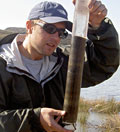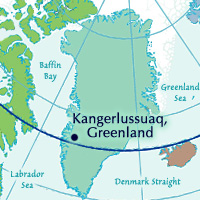Alkenones: Natural Thermometers
KANGERLUSSUAQ, GREENLAND– To understand how Earth’s climate system has changed over time, we need to find, develop and use natural recorders of temperature and precipitation.
One natural thermometer comes in the form of alkenones: trans-fats produced by certain algae. The alkenone thermometer is already used to reconstruct sea surface temperatures from ocean sediments. My research aims to extend their use to lakes, so we can reconstruct continental temperatures as well.
Watch this video to see how this biological thermometer works.
Get the Flash Player to see this player.











Your videos present subject matter in a way even a father can understand. Keep up the important work!
Are those the real picture of alkenones? Its amazing…..congratulations on the good work!
Wow, your clips are like PBS quality documentaries. Awesome. I’m glad this feature was easier for me to distinguish between fiction versus non-fiction unlike the “Lake Coring in NYC” feature I saw on YouTube, which I thought was… “Really?! People core lakes in NYC?!” I’m glad that I met you in Kanger and got that cleared! Did I just admit to the world that I’m an idiot by submitting this comment?
Geethaasokakumar,
Those are pictures of the algae that are producing the alkenones. I took those photos right through the ocular lens of a microscope using a simple Canon Elph! We “see” the alkenones as peaks on a line (like a heart monitor or lie detector) after separating them with a gas chromatograph…not quite as satisfying as a charismatic photo, but much more quantitative.
-Billy
Hi Billy,
I hope that you are well. Kate O’Donnell has suggested that I contact you as I am looking to get in touch with Dads who work in unusual locations across the world.
I’m working on a great new website which is aiming to help answer the question ‘how can I be a better dad?’ and right now were are looking for all types of Dads to help us test. We have Dads on almost every continent using the site and helping us develop it into a really useful tool. Kate has recommend that you would be a fantastic addition to our growing community, offering a viewpoint of someone who is away from home.
If you are interested, I would love to hear from you. I can set you up with a private invitation and you would really be helping us out.
I look forward to hearing from you soon.
Best wishes,
Jason
Great explanation of alkenones! Makes me want to work on Arctic lakes!
Hi Billy!
Reading your blog certainly bring back memories of the days spent at the geochem lab :) I can’t wait to hear more stories from Greenland.
Alkenone rocks!
Great job making that so simple to understand. I definately would have scored a few points higher on a geology test had a seen this video. I gots a couple questions:
1. What do you calibrate the degree of alkenone saturation against in order to predict past climate? Can you observe current alkenone production under different environmental stimuli?
2. Are there any other algae that can change their alkenone saturation in response to climate?
3. Are the alkenones part of the cell wall?
4. How do you evaluate the degree of saturation after gas chromatography? Mass spec?
This is sweet because this pertains to what I have been learning all summer, your practically an organic chemist.
Hi Robby,
1. We’d like to calibrate against algae cultures grown at different temperatures. That is why this field season was aimed at capturing the algae fom the lakes and keeping them alive. We’ll grow them at different temperatures and measure the degree of alkenone saturation they produce at different temps.
In the meantime, I’ve calibrated the degree of saturation to temperature using the thermocline of the lake. Since the water temperature gets colder with depth in these lakes, we filtered alkenones from different depths and measured the water temperature and alkenone saturation at these depths.
2. Only a handful of organisms on the planet make alkenones, and they are all members of the class of algae called Haptophyta.
3. People assumed they were cell wall compounds for a long time – and they are found there – but recent work has shown alkenones to be present all throughout the cell.
4. We evaluate the degree of saturation with a flame ionozation detector (FID) after the gas chromatograph. An FID is much more quantitative than a mass spectrometer for measuring absolute concentrations.
ahhhhhh very good, bookmarked :-) keep it up, JusyKassy.
Hi Billy,
I just found your page, good work Sir! I do not have a speaker on my work computer but look forward to watching your video with sound. How is Umass treating you? I hope you are somewhere North for the hot summer months.
Claire
awesome and fantastic website. I love very much, a lot of education to learn for. Cheers.. Happy Weekend… :)
Great website:)
Very educating blog, awesome and intresting.
I Love it. Have a Nice Day.
awesome video , useful inform